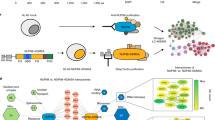Abstract
Acute myeloid leukemia 1 (AML1) gene on chromosome 21 is involved in several chromosomal translocations, including t(8;21) and t(16;21), that produce chimeric fusion proteins AML1–eight twenty-one (ETO) and AML–myeloid transforming gene chromosome 16 (MTG16), which contribute to leukemogenesis. The molecular basis for the leukemogenic effects of these fusion proteins is incompletely understood. Using gel-shift assay, we showed that AML1–ETO and AML1–MTG16 bound to a series of AML1 consensus DNA-binding sites with different affinities. Using fluorescence recovery after photobleaching (FRAP), we demonstrated that a fusion of AML1 with ETO or MTG16 exhibits reduced intranuclear mobility compared with wild-type AML1 or either fusion partner. The dimerization domain (nervy homology region 2) of ETO is responsible for the reduced mobility of AML1–ETO. Dual FRAP studies revealed that CBFβ colocalized with AML1–ETO within the nucleus, resulting in reduced mobility of CBFβ. Therefore, AML1 fusion proteins may interfere with normal AML1 function due to aberrant nuclear dynamics, which leads to spatial and temporal sequestration of CBFβ and perhaps other coregulators critical for myeloid differentiation.
This is a preview of subscription content, access via your institution
Access options
Subscribe to this journal
Receive 50 print issues and online access
$259.00 per year
only $5.18 per issue
Buy this article
- Purchase on Springer Link
- Instant access to full article PDF
Prices may be subject to local taxes which are calculated during checkout






Similar content being viewed by others
References
Adya N, Stacy T, Speck NA, Liu PP . (1998). Mol Cell Biol 18: 7432–7443.
Bangsow C, Rubins N, Glusman G, Bernstein Y, Negreanu V, Goldenberg D et al. (2001). Gene 279: 221–232.
Barseguian K, Lutterbach B, Hiebert SW, Nickerson J, Lian JB, Stein JL et al. (2002). Proc Natl Acad Sci USA 99: 15434–15439.
Davis JN, McGhee L, Meyers S . (2003). Gene 303: 1–10.
Dong S, Tweardy DJ . (2002). Blood 99: 2637–2646.
Dong S, Qiu J, Stenoien DL, Brinkley WR, Mancini MA, Tweardy DJ . (2003). Oncogene 22: 858–868.
Dong S, Stenoien DL, Qiu J, Mancini MA, Tweardy DJ . (2004). Mol Cell Biol 24: 4465–4475.
Francastel C, Magis W, Groudine M . (2001). Proc Natl Acad Sci USA 98: 12120–12125.
Gamou T, Kitamura E, Hosoda F, Shimizu K, Shinohara K, Hayashi Y et al. (1998). Blood 91: 4028–4037.
Harrington KS, Javed A, Drissi H, McNeil S, Lian JB, Stein JL et al. (2002). J Cell Sci 115: 4167–4176.
Hildebrand D, Tiefenbach J, Heinzel T, Grez M, Maurer AB . (2001). J Biol Chem 276: 9889–9895.
Hinojos CA, Sharp ZD, Mancini MA . (2005). Trends Endocrinol Metab 16: 12–18.
Hug BA, Lee SY, Kinsler EL, Zhang J, Lazar MA . (2002). Cancer Res 62: 2906–2912.
Korgaonkar C, Zhao L, Modestou M, Quelle DE . (2002). Mol Cell Biol 22: 196–206.
Licht JD . (2001). Oncogene 20: 5660–5679.
Lutterbach B, Hiebert SW . (2000). Gene 245: 223–235.
McNeil S, Zeng C, Harrington KS, Hiebert S, Lian JB, Stein JL et al. (1999). Proc Natl Acad Sci USA 96: 14882–14887.
Meyers S, Lenny N, Hiebert SW . (1995). Mol Cell Biol 15: 1974–1982.
Minucci S, Maccarana M, Cioce M, De Luca P, Gelmetti V, Segalla S et al. (2000). Mol Cell 5: 811–820.
Misteli T . (2001). Science 291: 843–847.
Peterson LF, Zhang DE . (2004). Oncogene 23: 4255–4262.
So CW, Cleary ML . (2004). Blood 104: 919–922.
Stenoien DL, Mancini MG, Patel K, Allegretto EA, Smith CL, Mancini MA . (2000). Mol Endocrinol 14: 518–534.
Stenoien DL, Patel K, Mancini MG, Dutertre M, Smith CL, O'Malley BW et al. (2001). Nat Cell Biol 3: 15–23.
Stewart MD, Li J, Wong J . (2005). Mol Cell Biol 25: 2525–2538.
Tanaka K, Tanaka T, Kurokawa M, Imai Y, Ogawa S, Mitani K et al. (1998). Blood 91: 1688–1699.
Westendorf JJ, Hiebert SW . (1999). J Cell Biochem 75 (Suppl 32–33): 51–58.
Yoon HG, Chan DW, Reynolds AB, Qin J, Wong J . (2003). Mol Cell 12: 723–734.
Zaidi SK, Sullivan AJ, van Wijnen AJ, Stein JL, Stein GS, Lian JB . (2002). Proc Natl Acad Sci USA 99: 8048–8053.
Zhang J, Hug BA, Huang EY, Chen CW, Gelmetti V, Maccarana M et al. (2001). Mol Cell Biol 21: 156–163.
Acknowledgements
We thank Dr Hisamaru Hirai (University of Tokyo, Tokyo, Japan) for AML1A, AML1-EVI1 and EVI1 vectors; Dr Scott W Hiebert (Vanderbilt University School of Medicine, Nashville, TN, USA) for AML1B and ETO vectors; Dr Pu P Liu (National Human Genome Research Institute, National Institutes of Health, Bethesda, MD, USA) for CBFβ and CBFβ-MYH11 vectors; Dr Fumiko Morohoshi (National Cancer Center Research Institute, Tokyo, Japan) for MTG16a and MTGR1 vectors and Dr Robynn V Schillace (Oregon Health and Sciences University, Portland, OR) for MTG16b vector. We greatly appreciate the helpful discussions of Dr Michael Mancini and the technical assistance of Dr David Stewart from the Department of Molecular and Cellular Biology of Baylor College of Medicine. This work was supported in part by grant #IRG 93-034-06 (to SD) from the American Cancer Society (ACS), Chao Award (to SD) from the Department of Medicine of Baylor College of Medicine and R21 grant CA119080 (to SD) from the National Cancer Institute (NCI).
Author information
Authors and Affiliations
Corresponding author
Rights and permissions
About this article
Cite this article
Qiu, J., Wong, J., Tweardy, D. et al. Decreased intranuclear mobility of acute myeloid leukemia 1-containing fusion proteins is accompanied by reduced mobility and compartmentalization of core binding factor β. Oncogene 25, 3982–3993 (2006). https://doi.org/10.1038/sj.onc.1209431
Received:
Revised:
Accepted:
Published:
Issue Date:
DOI: https://doi.org/10.1038/sj.onc.1209431
Keywords
This article is cited by
-
Dominant-negative mechanism of leukemogenic PAX5 fusions
Oncogene (2012)
-
The reduced and altered activities of PAX5 are linked to the protein–protein interaction motif (coiled-coil domain) of the PAX5–PML fusion protein in t(9;15)-associated acute lymphocytic leukemia
Oncogene (2011)
-
The X-linked mental retardation gene PHF8 is a histone demethylase involved in neuronal differentiation
Cell Research (2010)



